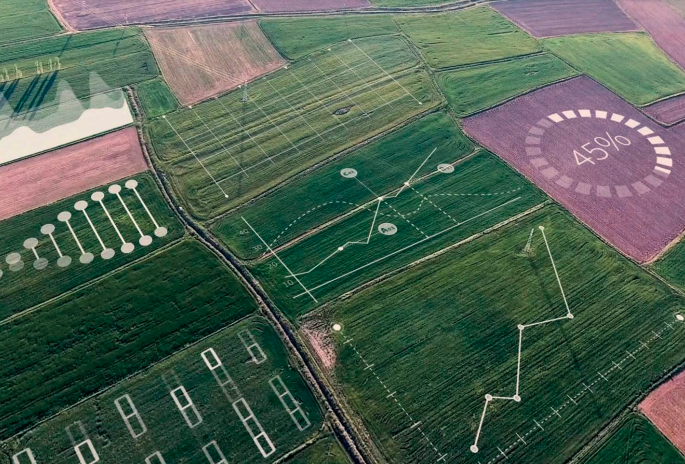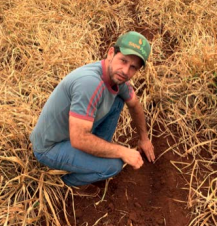Written by Mark Dewes, Agrii
I’ve been an agronomist since 1996, mainly in the independent sector but since 2015 I’ve been working for Agrii. I’ve always been curious as to why we work in the way we do with our farmer customers and what changes we could make to improve the service we provide

Guiding pesticide use is a big part of what we do. It’s also a political hot potato and an important part of the debate around future food production. A lot of this debate is one-sided and unhelpful. I want to help progress the discussion by exploring the way the pesticide market works, how it interacts with agronomists (as both it’s technical support and sales force), and how we should evolve to curate the products we use and serve our farmer customers in a more sustainable way. I have been fortunate to study agronomy systems in different parts of the world through a Nuffield Farming Scholarship funded by the Richard Lawes Foundation. Through this study I have come to some conclusions and made recommendations for how the UK agronomy sector should develop and react to the changing environment of crop production.
The genesis of the modern agronomist
A local farmer told me of his first memory of working with his agronomist from the 1950’s: “He rang at lunch time and told me to nip into Boots to pick up a can of 2-4D for the Long Meadow. He said that he’d leave it behind the Lipstick counter”. From these beginnings, the modern agronomist was born. While agronomists who make their money from selling products will recognise their origins in our Boots rep from the 1950’s, those who charge solely for their advice may not see the direct lineage.
The two main branches of the UK agronomist family tree are those of the supply and independent sectors. We have become competitors in the market to decipher the complexity of pesticide use for our farmer clients, and it is the perpetuation of this complexity which has, in part, evolved our role. Although independent agronomists do not profit from the sale of products, their position is equally reliant on the pesticide market as those who sell products directly. Our current raison d’etre as agronomists is to manage pesticide use for arable farmers – a point reinforced by the scarcity of agronomist input on organic arable farms.

The position of on-farm agronomists in the UK
A survey by HLH Ltd in December 2018 showed that 88% of farmers took regular advice from an agronomist. This out-sourcing of pesticide management to agronomists has contributed to a disengagement of farmers from their own agronomic decision making which seems greater than that which I observed in other countries. Some reasons for this include the amount of diversification on UK arable farms, a complex pesticide market and the compulsion by Red Tractor assurance schemes for farmers to engage qualified advisors. Systems in which agronomists operate as sub-contracted pesticide managers lack established lines of accountability. This applies both to agronomists who sell products and those who work independently. The decision-making nudges for both types of agronomist are almost all towards the use of pesticides. Research (including Rodrigues et al 2013) into the way doctors have over-prescribed antibiotics may offer a way of understanding the cultural and professional influences which can predispose agronomists to overprescription.
I believe the systems in which we work risk encouraging the use of crop protection products at levels above the economic optimum for growers and takes too little account of their longterm stewardship. The data collected on pesticide use are insufficient to determine how appropriately these products are being used at a landscape level, but studies conducted in France (Lechenet et al 2017) conclude that significant reductions in use could be made on most farms without reducing productivity.
Oilseed Rape is a prime example and since the loss of insecticidal seed dressings the use of foliar insecticides has ballooned, with questionable beneficial effect on OSR survival. There is very little about growing OSR currently in the UK which could be described as sustainable. Although the root of this problem is the decision to outlaw one set of active ingredients without due consideration of the unintended effects, it is the reaction of farmers and agronomists which drive the results we see on farm today. After several decades of conditioning that agronomists can prescribe an appropriate solution to any given crop problem, we appear to be reaching the end of that line. The lag in behavioural change of both farmers and agronomists demonstrates the inertia of a chain of advice and supply which needs to redefine itself for a new environment.
Agronomy abroad
So how do other countries approach the same issues? From travelling to Northern European countries and those on both the North and South American continents I learned a great deal about the way different systems have evolved with different positive and negative effects.
Turning to South America first, their leaning towards “payment by results” is very clear in the agronomy and pesticide market. I was fortunate to spend time at Sape Agro, a 7000 Ha farm growing Soya, Cereals, Sugar Cane and livestock in Western Brazil. Denillo is their inhouse agronomist and is paid according to a set of parameters which drive productivity and profitability through sustainable practices. The picture below shows him checking seed spacing on the soya crop which will be monitored through the season by drones to assess plant establishment. Denillo can use all of the agronomic tools at his disposal to maximise the performance of the farm and his own pay. The results suggest that this is a strategy which pays dividends.
Accountability and sharing the risks in the UK
I’ve been working on a version of this concept for the UK. At Agrii we are piloting Agrii Farm Partnerships: An agreement which makes crop Gross Margins the success criteria. What is different about this scheme is the commitment to a set of financial targets, the moderation of those targets according to the weather we are facing (to put the farmers’ agronomy partner to the task of out-performing the season) and the mechanism to share in the rewards when those targets are beaten and to share in the financial penalty when they are missed: In equal measure.
This partnership has been designed to incentivise the decision making of agronomists with the backdrop of declining benefits from pesticide use. By aligning the objectives of agronomists and farmers completely we can harness the skills of each to drive towards a common goal which is measured, moderated and rewarded (or penalised) depending on performance relative to the season. For example, where national yields are 10% above the rolling fiveyear average then the target yields (based on the potential of that specific farm) in the agreement are increased by the same percentage: And Vice Versa.
This risk-sharing concept is creeping into the arable input supply chain, notably with regard to Oilseed Rape establishment and also with Bayer Crop Science’s recent pilot launch of their outcome-based pricing models. Agrii Farm Partnerships aims to take that concept further and apply lines of accountability to the whole agronomic decision-making process in the way that works successfully in South America. In future articles I will explore the legislation we might face with regard to pesticide use and what we might do to help shape it in a positive way. I’ll also look at ways in which farmers are finding solutions to their crop problems from their peer groups as well as just from their agronomists.